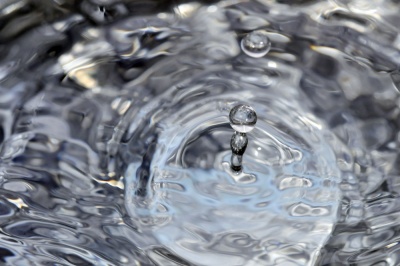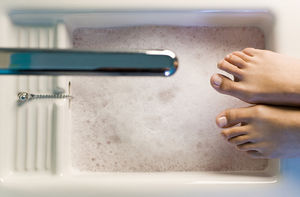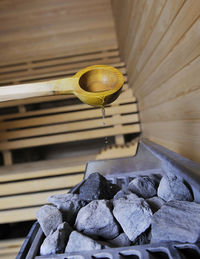Hydrotherapy
From Health Facts
Latest Edit: Hector 2014-03-13 (EDT)
| See Also | Naturopathic Therapies |
|---|
Hydrotherapy has been used as a form of healing since the early 1800s. The main contributors to hydrotherapy include:
- Vincent Priessnitz (1799-1851) is considered the founder of the hydrotherapy-nature cure movement. Priessnitz relied on nothing except cold water, air, a simple diet, and physical activity to heal his patients. Johann Schroth (1798-1856) disagreed with, what he preceived to be, Priessnitz's extreme use of the cold water and he prescribed long-lasting warm moist packs and hot baths. [1] Both Vincent Priessnitz and Schroth enjoy much success, even though their treatments were diametrically opposed.
- J.H. Rausse was the first person to lay down the scientific priniciples of water cure. In 1837 he spend ten weeks receiving treatments from Priessnitz and he began to ponder the principles underlying water cure. wrote The Spirit of the Graefenburg Water Cure in 1838. His writings increased Priessnitz's fame. His cousin, Theodor Hahn (1824-1883), a chemist and a contemporary of Vincent Priessnitz, advocated using water cure along with a vegetarian diet. Hahn promoted the belief that the nature doctor should educate people on how to live a healthy life, how to use natural treatments, and to realize personal responsiblity for their own health. He wrote a system of water cure known as "Enforced water cure" and he wrote the book Hahn's Water Doctor.
- Of greatest and lasting influence was the work of Father Sebastian Kneipp. Using an eclectic and integrated approach, Kneipp combined hydrotherapeutic baths with heliotherapy (sunshine), exercise, vegetarian and fruit diets, and the indigenous European herbs so well known to him. Father Kneipp provided the link between the European nature cure and American Naturopathy.[2]
- Johann Schroth (1798 – 1856) was a layman, not a practitioner. When he smashed his knee in an accident with a horse he was advised to use the Priessnitz method of cure. In order to avoid the frequent changing of the packs, as prescribed by the Priessnitz method, he placed several packs on top of one other and wrapped his whole knee with a woollen cloth which he left on for several hours. The moist heat worked and he was cured. What he theorized was that the moist heat caused the poisonous toxins to dissolve and be swept away. Over time he developed the famous Schroth cure in which dry food and little else is taken, in conjunction with the use of damp packs. The Schroth cure was renamed by Bilz to “the regenerative treatment” and it was used for chronic diseases through the use of an extreme diet following total fasting by withdrawing of all food and drink and then the use of totally dry grain products and the eventual reintroduction of fluids. F.E. Bilz, was also a lay practitioner who established a Nature Cure sanitarium in Germany and he is the author of the first Naturopathic encyclopedia, The Natural Method of Healing, which has been translated into a dozen languages, and in German alone has run into 150 editions.[1] Both Vincent Priessnitz and Schroth enjoy much success, even though their treatments were diametrically opposed.
- In the early 1900s Dr. Otis G. Carroll, a naturopathic doctor from Illinois, modernized hydrotherapy techniques by introducing constitutional hydrotherapy, a series of hot and cold compresses applied to the chest, abdomen and back during which the patient is wrapped in blankets. The concepts of constitutional hydrotherapy were furthered by NDs Leo Scott and Harold Dick and then in the 1980s by Dr. Andre Saine, ND.[2]
- German healers continue to be the active proponents of hydrotherapy as a signification means of treating disease.[3]
Physiological Effects
The unique properties of water contribute to its effectiveness as a therapeutic agent. The main physiological effects of hydrotherapy can be classied as thermal, mechanical, and chemical.[3]
- Thermal:
- Mechanical:
- Chemical:
Hydrotherapy in Practice
- Constitutional Hydrotherapy
- Constitutional Hydrotherapy originated with Dr. Otis G. Carroll in 1908. Involves the use of alternating hot and cold water directly on the skin.
- Conditions that may benefit include as cancer, arthritis, fibromyalgia, heart disease, migraines, environmental toxicity, and many others.
- Foot baths
- Compresses using either hot water, cold water or alternating between hot and cold.
- Steam baths
- Infrared sauna
- Involves the use of emissions of light in the infrared wavelength to create a heat source that goes beyond the surface of the skin to the lymphatic tissue and organs beneath. As you sit in the sauna, the infrared wavelengths emitted meet the skin surface and heat up the skin and underlying tissues to a depth of 3.5-4 inches. This creates an increase in lymphatic drainage via sweating, as the majority of the lymphatic system is located underneath the skin’s surface. As you begin to sweat, the lymphatic system eliminates any toxins via the skin pores, greatly enhancing the circulation of lymphatic fluid and furthering the toxin elimination. Your naturopathic doctor will outline a protocol for you to follow for this treatment.
Hydrotherapy Research
| Article | Hydrotherapy Self-Care in Osteoarthritis: Cooperating with the Healing Power of Nature, Vital Link; 2009 Fall |
|---|
Hydrotherapy is not a treatment modality that has undergone extensive research. Some articles that provide a look at the physiological effects of hydrotherapy include:
| Article | Hydrotherapy Protocols for Sleep Disorders, NDNR 2012 March |
|---|
- A study that demonstrated a link between cold water exposure in swimmers and a decrease in uric acid and an increase in the level of oxidized glutathione. The reaction was interpreted as stress response adaptation.[4]
- Cold-wet sheet packs applied to the trunk of patients suffering from chronic cardiac, rheumatic and metabolic diseases was found to be beneficial both physically and mentally.[5]
References
- ↑ 1.0 1.1 Kirchfield Friedhelm, Boyle Wade (1994) Nature Doctors: Pioneers in Naturopathic Medicine NCNM Press, Portland Oregon.
- ↑ 2.0 2.1 Lloyd Iva (2009) The History of Naturopathic Medicine, a Canadian perspective McArthur & Company, Toronto.
- ↑ 3.0 3.1 Barry Robert Hydrotherapy In Pizzorno Joseph E, Murray Michael (1999) Textbook of Natural Medicine, Second Edition Churchill Livingstone.
- ↑ Siems WG, van Kuikj FJ, Maass R et al. Uric acid and glutathione levels during short-term whole body cold exposure. Free Radical Biol Med 1994; 16:299-305.
- ↑ Kuhn G, Buhring M. Physical medicine and quality of life: design and results of a study on hydrotherapy. Comp Ther Med 1995; 3:138-141.


